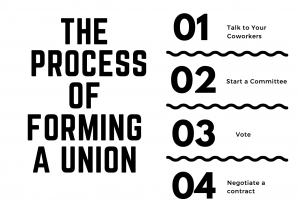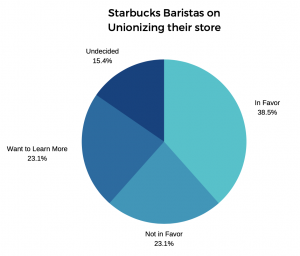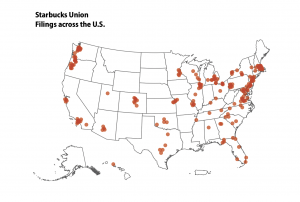Across the United States, more Starbucks locations are turning to unions in hopes to find more support for their employees.
What started as a small effort by two Starbucks locations in Buffalo, New York, has spread across the country. These stores cited nearly 20 unfair labor practices that had been going on in their location. After a vote held this December, the number of Starbucks stores with a union, increased to six, with more locations getting voted on in the coming months.
Since Buffalo’s successful attempt at independence, several other Starbucks locations have followed suit with over 105 locations across 26 states filing petitions to the National Labor Relations Board for their union elections.
A labor union, as defined by UnionPlus, is “an organized group of workers who unite to make decisions about conditions affecting their work”. The purpose of these unions is to take the power away from corporate and give it to the workers who devote their livelihood to the Starbucks brand.
But why are Starbucks employees turning to unions? According to baristas, one reason is poor management.
“Our employee turnaround has been awful,” Barista Devin Rossi said, “Since I started last May, there are only one or two people who have stayed. We’ve had managers come and go, some for a few months, others filling in temporarily for a few weeks. I don’t think forming a union is always the answer, but at this point, corporate has to know that there’s an issue and they should work on solving it instead of letting their baristas flounder.”
Another reason baristas have been forming unions is because of low pay. Although the minimum wage has seen an increase in recent years, many baristas are feeling that it is not enough for the amount of work they do to meet the expectations of management. In Illinois, the starting wage at Starbucks is $12 per hour, whereas some union locations have been able to secure a $25 minimum wage for employees.
Baristas are also seeking more medical support from Starbucks Corporate.
“I quit last summer due to health-related reasons,” said former barista Rachel Townsend, “There were times when I needed to work long hours while understaffed. Management didn’t know how to accommodate me fast enough so I made the decision to quit.”
After years of dwindling statistics, union popularity is on the rise. With 68% of people being in support of them. Amazon employees have also begun petitioning in recent months as they feel their work environment is unsafe and their work conditions are unfair.
Today, the process of forming a union is easier than ever. Any location wondering about their options can meet with a union organizer, look through handbooks, and campaign for their stores.
However, some Starbucks workers do not feel a desire to unionize, feeling that there is no need for the hassle.
“I understand why some locations feel the need to take these steps, but I don’t think it’s necessary,” One barista said, “If you think the work is hard, quit. I know people who have worked here for 10 plus years and they love the work they do. Just figure out a job that’s best for you.”
A handful of employees from one Starbucks location, which chose to stay anonymous (until they decide on their next step), were surveyed about their desire to form a union. While some were undecided, several baristas expressed a desire to look into their options and start the process.
Many Starbucks locations are taking a close look at the stores that have taken the union route. Some employees see other stores’ efforts as inspiration, reminding other baristas how they deserve to be treated and what they are capable of.
“Part of it is just seeing what our options are,” Sarah said, “Sometimes it can feel like something bigger than us, but when you hear other locations’ stories and see that it isn’t impossible. It gives you the push to do the right thing.”
